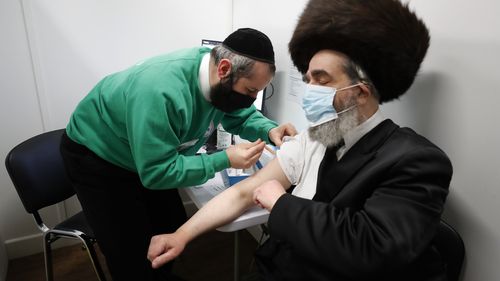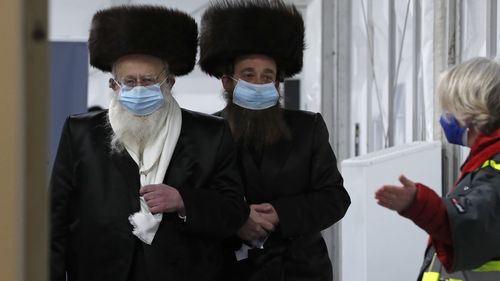Some 15 million people, or 22 per cent of the UK population, have received their first shot or were offered one. The figure includes most people in the government’s top four priority groups, including everyone over 75, frontline healthcare workers and nursing home staff.
“15,000,000! Amazing team,” Nadhim Zahawi, the vaccines minister, said in a tweet that featured a red heart. “We will not rest till we offer the vaccine to the whole of phase1 the 1-9 categories of the most vulnerable & all over 50s by end April and then all adults.”

British Prime Minister Boris Johnson plans to unveil his roadmap for easing restrictions on February 22 amid signs that infection rates, hospitalisations and deaths have fallen sharply since England’s third national lockdown began on January 4.
Jockeying has already begun between those who want the measures lifted as soon as possible and those who fear moving too fast will lead to a resurgence of the virus.
Britain got a head start on its vaccination effort in December, when it became the first country to authorize widespread use of a COVID-19 shot. It ranks behind only Israel, 71 per cent, the Seychelles, 53 per cent, and the United Arab Emirates, 50 per cent in the percentage of people who have received one dose, according to data compiled by Oxford University. The US is fifth at 15 per cent.
At the same time, rules that have closed schools, restaurants and nonessential shops in the UK are starting to pay off. The number of new infections, hospital admissions and deaths recorded over the past seven days have all dropped by more than 20 per cent from the previous week, according to government figures.
When Johnson announced the lockdown, he said the government would review the measures in mid-February based on their success in controlling the pandemic and progress in the vaccination effort. Johnson’s first priority is to reopen schools, and he has promised to give schools two weeks notice to give teachers time to prepare for the return of students.
The prime minister on Saturday applauded the vaccine rollout but urged people to be cautious.
“We have still got infections running very high throughout the country — levels which last year we would have thought were really very high indeed — (and) still, sadly, a great many deaths in our hospitals,” he said during a visit to a vaccine manufacturing facility in northeastern England. “Although the number is beginning to come down, and perhaps starting to come down quite fast, we need to look at the data very, very hard.”
Britain has reported over 117,000 virus-related deaths, the highest toll in Europe.
Mark Harper, a member of Parliament from the ruling Conservative Party, last week warned the government against “moving the goalposts” for deciding when to ease the lockdown.


Johnson should start by reopening schools, then gradually lift other restrictions as more people are vaccinated, said Harper, who leads a group of about 70 lawmakers who have lobbied for the government to consider the negative economic and social impacts of the restrictions, along with the health benefits.
“If you think about the restrictions that the government’s placed on everybody, they are the toughest set of restrictions that have ever been placed on the British people outside of the Second and First World Wars,” Harper told the BBC. “So it’s kind of just worth stepping back a bit and saying, ‘This isn’t normal, and it shouldn’t continue, frankly, for a moment longer than it’s absolutely necessary.'”
After meeting the target for reaching the most vulnerable people, UK authorities will progressively expand the vaccination drive to the next five priority groups until everyone over 50 and vulnerable younger people with health conditions that put them at higher risk from the virus have been offered the vaccine.
Public health officials say the top nine priority groups account for 99 per cent of the deaths caused by COVID-19 so far.
While the vaccines currently authorised for use in the UK require two doses to ensure full protection against COVID-19, British authorities say one dose provides a significant level of protection.

Because of this, they have made it their priority to give the first dose to as many people as possible as quickly as possible. To do this, Britain has suggested that the second dose be administered after three months, instead of one month as recommended by the manufacturers.
Jeremy Farrar, director of the Wellcome Trust health think tank, said the number of COVID-19 infections in Britain is still too high to think about lifting the restrictions.
“We’ve made enormous progress … but the transmission is incredibly high still and we’ve got to get it lower,” he said.
There are other dangers on the horizon. UK government scientific advisers say the COVID-19 variant now predominant in the country may be up to 70 per cent more deadly than previous variants, underscoring concerns about how mutations may change the characteristics of the disease.
The findings from the New and Emerging Respiratory Virus Threats Advisory Group, published Friday on the government’s website, confirm preliminary research released January 21. The group, known as NERVTAG, includes experts from universities and public agencies across the UK.
The new report is based on analysis of a dozen studies that found the so-called Kent variant, named after the county where it was first identified, was 30 per cent to 70 per cent more deadly than other variants. The studies compared hospitalisation and death rates among people infected with the variant and those infected with other variants.
“Based on these analyses, it is likely that infection with (the Kent variant) is associated with an increased risk of hospitalisation and death compared to infection with non-variant of cancer viruses,” the advisory group said. “It should be noted that the absolute risk of death per infection remains low.”
This content first appear on 9news
